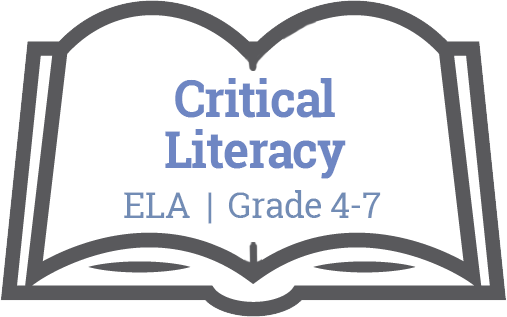
Unit Plan: Critical Literacy
English Language Arts / Grade 4-7

Big Ideas
Texts can be understood from a variety of perspectives. (Grades 4-5)
Exploring and sharing multiple perspectives extends our thinking. (Grades 6-7)
Concepts:
- Reflection
- Values
- Beliefs
- Perspective
- Social Justice
Essential Questions
Students will keep considering…
- What does it mean to be critically literate?
- What is the relationship between critical literacy and social justice?
- How do our personal values, beliefs, and perspectives influence our understanding of texts?
- How do texts communicate social relationships?
- What does it mean to consider a different perspective?
- What strategies can readers use to critically analyze texts in a critical manner?
Evaluative Criteria
Teacher Evaluative Criteria:
Juxtaposing:
> Ability to compare texts
> Social implications of values, beliefs, perspectives are considered
> Depth of analysis- textual evidence used to support ideas
Switching:
> Ability to make switches in a text and show the impact of a switch on the text
Summative:
> Evidence that Critical Literacy skills have been applied
> Social implications are addressed, e.g., race, gender.
> Depth of analysis
> Textual evidence used to support ideas
Monitoring Progress
Teacher will monitor progress:
N/A
Potential Student Misunderstandings:
N/A
Resources
UNIT RESOURCES
- Textual Evidence Video
- Three Little Pigs Video
- The True Story of the Three Little Pigs Video
- The True Story of the Three Little Pigs by Jon Scieszka
- Mean Jean the Recess Queen by Alexis O’Neill
- Enemy Pie by Derek Munson
- #1000blackgirlbooks by Marley Dias
PROFESSIONAL RESOURCES FOR CRITICAL LITERACY
- The Four Dimensions of Critical Literacy
- Critical Literacy at Learn NC
- Seeing Multiple Perspectives: An Introductory Critical Literacy Lesson
- Connecting Practice and Research: Critical Literacy Guide
- Metacognitive Strategies
- Using Read-Alouds with Critical Literacy Literature in K-3 Classrooms
- Critical Literacy at the Government of Ontario
- McLaughlin, M., & DeVoogd. (2004). Critical literacy: enhancing students’ comprehension of text. New York: Scholastic.
- Comber, B. (2001). Critical literacy: Power and pleasure with language in the early years. Australian Journal of Language and Literacy, 24(3), pp.168–181.
- Wilhelm, J.D. (2007). Engaging readers & writers with inquiry: Promoting deep understandings in language arts and the content areas with guiding questions. New York: Scholastic.
Reflection
How will teachers and their students reflect on and evaluate the completed project?
Teacher:
Next time I teach this unit I would…
Student:
My students needed:
Process:
Product:
Content:
Potential Student Misunderstanding:
- Students might assume that a story is just a story and does not communicate information about values and beliefs.
- Students may forget to “read” the pictures along with the text and may need scaffolding to use viewing strategies to deconstruct the images.
- Students may need concept of textual evidence reinforced and modeled several times.
- Students may need additional practice identifying perspectives present, take time each day to model identifying perspectives for students. It is possible to extend this into other areas such as social-emotional learning and conflict resolution by having students identify and explain the perspective of others involved in real life situations.
Downloads
Unit Overview
Subject
English Language Arts
Topic
Critical Literacy
Unit Overview
This unit is an introduction to the concept of Critical Literacy. It builds on students reading skills of comprehending and connecting. This unit would be an excellent precursor to critical literacy during the beginning portion of the year to allow for deeper comprehension and meaning making later on in curricular content areas. Critical Literacy is a useful and appropraite approach for the social justice areas of the curriculum such as governance, resource use, land use, and interconnectedness, First Peoples knowledge, and personal choices.
Critical Literacy is an instructional approach that refers to the ability to read texts in an active, reflective manner in order to better understand power, inequality, and injustice in human relationships. This unit focuses on identifying the social implications of picture book fictional texts in order to build student comfort level and skill with Critical Literacy before students transfer those skills to content area , non-fiction texts.
This unit can be adapted for any grade or ability level by changing the level of the texts used, and assigned, by the teacher.
Grade
4-7
Unit Duration
4-5 weeks
Related Big Ideas
Science: 4-7
Socials: 4-7
Physical and Health Education: 4-7

The following resources are made available through the British Columbia Ministry of Education. For more information, please visit BC’s New Curriculum.
Big Ideas
The Big Ideas consist of generalizations and principles and the key concepts important in an area of learning. The Big Ideas represent what students will understand at the completion of the curriculum for their grade. They are intended to endure beyond a single grade and contribute to future understanding.
Core Competencies
 Communications Competency
Communications Competency
The set of abilities that students use to impart and exchange information, experiences and ideas, to explore the world around them, and to understand and effectively engage in the use of digital media
 Thinking Competency
Thinking Competency
The knowledge, skills and processes we associate with intellectual development
 Social Competency
Social Competency
The set of abilities that relate to students’ identity in the world, both as individuals and as members of their community and society
Curricular Competencies & Content
Curricular Competencies are the skills, strategies, and processes that students develop over time. They reflect the “Do” in the Know-Do-Understand model of curriculum. The Curricular Competencies are built on the thinking, communicating, and personal and social competencies relevant to disciplines that make up an area of learning.
Additional Resources
First People's Principles of Learning
To read more about First People’s Principles of Learning, please click here.
For classroom resources, please visit the First Nations Education Steering Committee.
